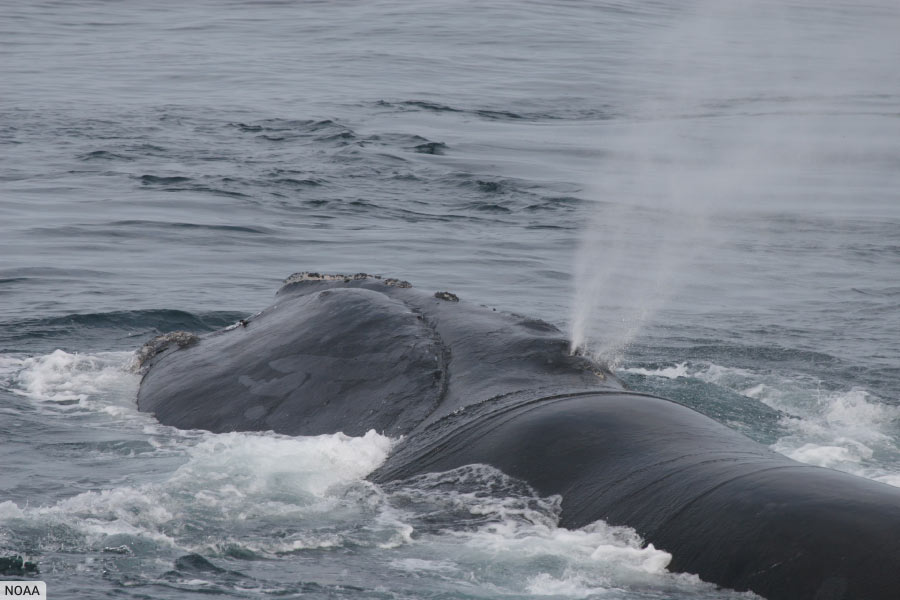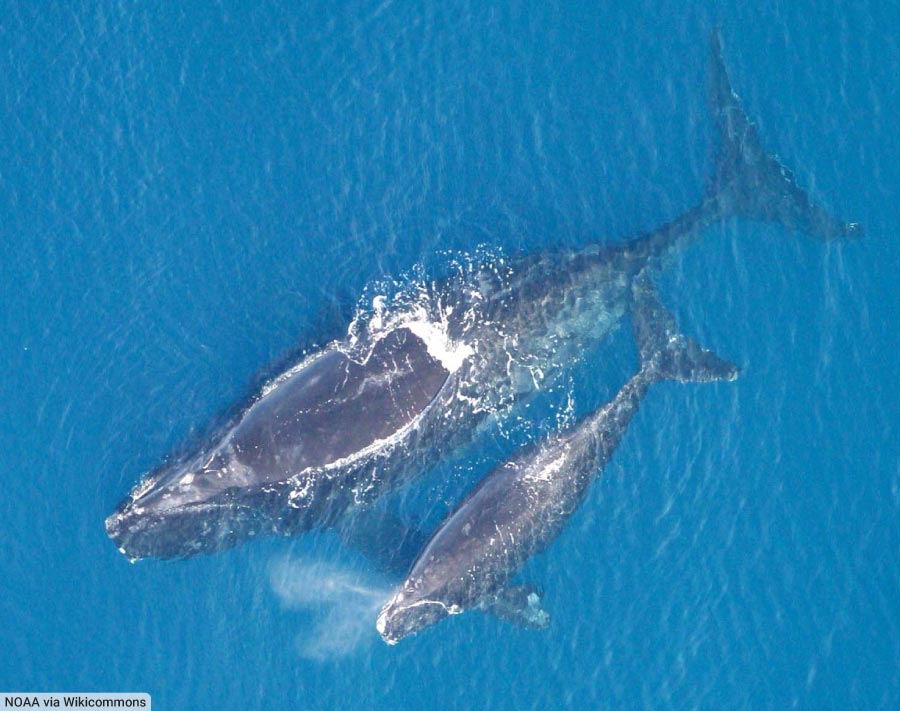The North Atlantic Right Whale (Eubalaena glacialis) is a critically endangered baleen whale species. On this page is a complete guide to this large marine mammal…
Page Index
- North Atlantic Right Whale Fun Facts
- What Is A North Atlantic Right Whale?
- North Atlantic Right Whale Statistics
- What Does A North Atlantic Right Whale Look Like?
- Related Species
- Classification of the North Atlantic Right Whale within Cetacea
- North Atlantic Right Whale Range & Migration
- North Atlantic Right Whale Diet & Hunting
- North Atlantic Right Whale Life Cycle
- Are North Atlantic Right Whales Endangered?
- North Atlantic Right Whale Population
- North Atlantic Right Whale Predators
- Discover More with Active Wild
Discover every living species of whale on this page: Types of Whales
North Atlantic Right Whale Facts

- The North Atlantic right whale, like other baleen whales, is a filter feeder, separating food from the water with the comb-like baleen plates in its mouth.
- The closest land-living relative of the North Atlantic right whale (and all cetaceans) is the hippo.
- The North Atlantic right whale is one of the most endangered of all whales with an estimated adult population consisting of just 250 individuals.
- The North Atlantic right whale is one of three right whales. Until early in the 21st Century, they were considered to be a single species.
- Individual North Atlantic right whales can be identified by the callosities (rough patches of skin) on their heads, which are white in color due to the presence of whale lice (small crustaceans that live on whales and other cetaceans).
What Is A North Atlantic Right Whale?

The North Atlantic right whale (Eubalaena glacialis) is a large marine mammal belonging to the family Balaenidae. It is one of three species of right whales, possibly named so by whalers who considered them the "right" whales to hunt due to their slow speeds, tendency to float when dead, and copious amounts of oil and baleen.
North Atlantic right whales inhabit the North Atlantic Ocean, often found along the coastal waters of the eastern United States and Canada. During winter, they migrate to calving grounds in the southeastern United States.
The species is characterized by its large size, with adults typically reaching lengths of 13-16 meters (43-52 feet) and weights ranging from 40,000 to 70,000 kilograms (88,185-154,324 lb). The whale has a robust, rotund body, no dorsal fin, and a distinctive, V-shaped blowhole spray.
The North Atlantic right whale primarily feeds by skimming the water for tiny crustaceans known as copepods, along with other small creatures. Despite its size, it is known for its acrobatic behavior, often breaching and slapping the water with its tail fluke.
Whale hunting decimated the North Atlantic right whale population and the species has never recovered. It is currently (July ’23) listed as Critically Endangered. One of the world’s most endangered whales, the North Atlantic right whale is in danger of becoming extinct.
North Atlantic Right Whale Statistics
- Scientific Name: Eubalaena glacialis
- Order: Cetartiodactyla
- Family: Balaenidae
- Length: 13-16 meters (43-52 feet)
- Weight: 40,000-70,000 kg (88,185-154,324 lb)
- Where Found: North Atlantic Ocean, particularly in the coastal waters off the eastern United States and Canada. During the winter, they migrate to calving grounds in the southeastern United States.
- IUCN Conservation Status: Critically Endangered
What Does A North Atlantic Right Whale Look Like?

The North Atlantic right whale has a robust and rotund body. It's typically around 13-16 meters in length (43-52 feet), making it one of the larger species of whales.
Its color is predominantly black, sometimes with white patches on the underside. A key characteristic is the lack of a dorsal fin, which distinguishes it from many other whale species. Its tail, or fluke, is wide, smooth, and black, and its pectoral (side) flippers are relatively long and paddle-shaped.
One of the distinguishing features of North Atlantic right whales is their callosities - rough, thickened patches of skin, present on their heads, particularly around the blowhole, eyes, and chin. These callosities are inhabited by small, whitish or cream-colored crustaceans called cyamids or "whale lice," making the callosities appear lighter in color than the surrounding skin.
The North Atlantic right whale has a broad, flat back and a large head that accounts for about a quarter of its total body length. Its mouth has a strongly arched, or bowed, jawline when viewed from above or below, which is another characteristic feature of the species.
The whale's blowholes are configured in a distinctive V-shape, and when it exhales, the spout of mist and warm air can reach up to 5 meters (16 feet) high.
Related Species
The North Atlantic right whale is classified within the infraorder Cetacea, a group that includes all the world's whales, dolphins, and porpoises.
This infraorder is part of the order Artiodactyla (sometimes known as Cetartiodactyla), which also includes land-living even-toed ungulates like deer, cows, and pigs.
Within Cetacea, there are two primary subgroups: Mysticeti (baleen whales) and Odontoceti (toothed whales). The North Atlantic Right Whale is classified within the Mysticeti, characterized by the presence of baleen plates for filter feeding rather than teeth.
Within the Mysticeti, the right whale belongs to the family Balaenidae, which is home to four living species: the three right whales of genus Eubalaena, and the bow whale, the only living member of the genus Balaena.
The other two species of right whale are the North Pacific right whale and the Southern right whale.
Classification of the North Atlantic Right Whale within Cetacea
- Order – Cetartiodactyla
- Infraorder – Cetacea
- Suborder – Mysticeti
- Family – Balaenidae
- Genus – Eubalaena
- Species – Eubalaena glacialis
Range & Migration

The North Atlantic right whale primarily inhabits the North Atlantic Ocean. It has a range that spans from the subtropical waters to the subarctic waters.
During the summer and fall, North Atlantic right whales are often found feeding in areas off the eastern coast of Canada and the northeastern United States, particularly in the Gulf of Maine and Bay of Fundy.
In the winter and early spring, these whales migrate to the warmer waters off the southeastern United States, where they give birth and nurse their young. The calving grounds are primarily located off the coast of Florida and Georgia.
Despite its name suggesting a North Atlantic distribution, the range and movement patterns of the North Atlantic right whale are more limited in the modern day due to significant population declines. The species has been sighted less frequently in some historical habitats, such as the waters off Iceland and Norway.
The North Atlantic right whale generally prefers coastal and shelf waters, but its exact distribution can vary from year to year, influenced by the availability of its preferred prey, among other factors.
Diet & Hunting

The North Atlantic right whale primarily feeds on small marine organisms known as zooplankton, particularly tiny crustaceans called copepods, and to a lesser extent, krill.
Copepods are minute invertebrates that float freely or drift in ocean waters, forming a major part of the marine food chain. They are rich in energy, which makes them a valuable food source for the whales.
North Atlantic right whales are baleen whales, meaning they have a system of baleen plates in their mouths instead of teeth. They feed by a process called skim feeding, swimming slowly with their mouths open at or just below the water's surface, filtering food from the water as it enters their mouths. The baleen plates trap the prey inside, while the water is expelled back out.
Although they consume millions of these tiny creatures every day, North Atlantic right whales typically feed intensively only during certain seasons or in certain areas where copepod densities are high. As such, their feeding habits can be influenced by the seasonal and geographic distribution of their prey.
North Atlantic Right Whale Life Cycle

Female North Atlantic right whales give birth to a single calf, usually in the winter months, after a gestation period of about one year. The species’ birthing and nursing grounds are typically located in warmer, shallower coastal waters off the southeastern United States, especially off Florida and Georgia.
The calves, measuring about 4-6 meters long at birth, remain with their mothers and are nursed for about a year, during which they grow rapidly, gaining significant weight and size. During this time, the mother-calf pairs often stay separate from larger groups of adults.
After weaning, juveniles grow more slowly and gradually become independent. Sexual maturity is reached at around 10 years of age, though this can vary.
Once mature, females tend to have a reproductive cycle that involves birthing a calf approximately every three to five years. This rate can be influenced by the whale's health, nutritional status, and environmental conditions.
Is The North Atlantic Right Whale Endangered?
The North Atlantic right whale is critically endangered, and, with a decreasing population currently numbering in the low hundreds, is in real danger of becoming extinct. The main factors that have contributed to the whale's critically endangered status are listed below:
Historical Whaling: Right whales were possibly named because they were the "right" whales to hunt. They're slow swimmers, they float when killed, and they yielded large amounts of oil and baleen. As a result, they were heavily targeted by commercial whalers from the 17th century until the early 20th century, causing their populations to plummet.
Vessel Strikes: Today, one of the most common causes of death for North Atlantic Right Whales is being struck by large ships. Their preference for coastal habitats and their slow swimming speed make them particularly vulnerable to this threat.
Entanglement in Fishing Gear: Entanglement in commercial fishing gear, particularly lobster and crab pot lines, is another significant cause of injury and death for these whales. Entanglements can cause serious injury, long-term health impacts, and often, a slow and painful death.
Habitat Degradation: Human activities such as coastal development and pollution can degrade the whales' habitats, impacting their access to food resources and safe spaces for calving.
Climate Change: Changes in sea temperature and other oceanographic conditions driven by climate change can affect the distribution and abundance of the whales' primary food source, copepods. This can lead to changes in the whales' feeding and migration patterns, potentially putting them at greater risk from other threats.
Low Reproductive Rate: Right whales have a slow reproductive rate which makes it difficult for the population to recover from these threats. Females give birth to a single calf after a year-long gestation period and then spend several years nursing and caring for the calf before they reproduce again.
Population
The current North Atlantic right whale population is estimated to consist of between 200 and 250 mature individuals, and is thought to be declining.
Predators
The North Atlantic right whale has few natural predators due to its large size. However, there have been occasional reports of killer whales (orcas) attacking right whales, particularly calves or young juveniles. Additionally, larger sharks may also pose a potential threat to young whales or weakened adults.
Discover More with Active Wild
Complete guide to the animal kingdom: Animals
Discover every living species of dolphin: Types of Dolphins
Discover every living species of whale on this page: Types of Whales
You can see more ocean animals on this page: Ocean Animals List with Pictures & Facts

